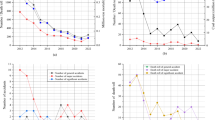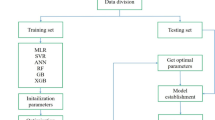Abstract
Coal mine gas accident is one of the most serious threats in the process of safe coal mine mining, making it important to accurately predict coal mine gas emission. To improve the accuracy of coal mine gas emission prediction, a hybrid machine learning prediction model combining random forest (RF) algorithm, improved gray wolf optimizer (IGWO) algorithm and support vector regression (SVR) algorithm is proposed, the model prediction effect is validated by using actual measured gas emission data from a coal mine. Firstly, the RF algorithm is used to screen 13 influencing factors of coal mine gas emission, and finally 6 influencing factors are selected as the input variables of the prediction model; Secondly, the GWO algorithm is improved using the nonlinear convergence factor and DLH search strategy to obtain the IGWO algorithm; Finally, the IGWO algorithm is used to optimize the parameters of the SVR algorithm, and the RF-IGWO-SVR model is established. The results show that the mean absolute percentage error, mean absolute error and root mean square error of the RF-GWO-SVR model are 1.55%, 0.0759, and 0.1103, respectively, and this result is better than the other comparative models, which indicates that the model can effectively improve the prediction accuracy of coal mine gas emission and provide a new model for coal mine gas emission prediction.










Similar content being viewed by others
Data Availability
The experimental data used to support the findings of this study are available from the corresponding author upon request.
Abbreviations
- RF:
-
Random forest
- GWO:
-
Gray wolf optimizer
- IGWO:
-
Improved gray wolf optimizer
- SVR:
-
Support vector regression
- RBF:
-
Radical basis function
- DLH:
-
Dimension learning-based hunting
- PCA:
-
Principal component analysis
- ELM:
-
Extreme learning machine
- BP:
-
Back propagation neural network
- MAPE:
-
Mean absolute percentage error
- MAE:
-
Mean absolute error
- RMSE:
-
Root mean square error
- R2 :
-
Linear regression coefficients of determination
References
Abu El-Magd SA, Ali SA, Pham QB (2021) Spatial modeling and susceptibility zonation of landslides using random forest, nave bayes and k-nearest neighbor in a complicated terrain. Earth Sci Inform 1–17
Adhikary J, Acharyya S (2022) Randomized Balanced Grey Wolf Optimizer (RBGWO) for solving real life optimization problems”. Appl Soft Comput 117:108429
Airey EM (1968) (1968) Gas emission from broken coal: an experimental and theoretical investigation. Int J Rock Mech Min Sci 5(4):475–494
Al-Betar MA, Awadallah MA, Faris H, Aljarah I, Hammouri AI (2018) Natural selection methods for grey wolf optimizer. Exp Syst App 113
Bakhtiar MSA, Zargar G, Riahi MA, Ansari HR (2020) Sand fraction prediction from seismic attributes using optimized support vector regression in an oil reservoir. Earth Sci Inform 13(1)
Bengio Y (2004) Grandvalet Y (2004) No Unbiased Estimator of the Variance of K-Fold Cross-Validation. J Mach Learn Res 5:1089–1105
Bing LI, Zhang C, Xinjie LI, Wang X (2016) Prediction of mine gas emission based on pca-elm. World Sci-Tech R & d 38(1):49–53
Cortes C, Vapnik VN (1995) Support vector networks. Mach Learn 20(3):273–297
Dendi S, Channappayya SS (2020) No-reference video quality assessment using natural spatiotemporal scene statistics. IEEE Transact Imag Proc PP(99):1–1
Dong X, Jia J, Bai Y, Fan C (2016) Prediction for gas-gushing amount from the working face of stope based on the SVM coupling genetic algorithm. J Saf Environ 16(02):114–118
Gao K, Shengnan L, Bin S, Yujiao L, Lianzeng S (2021) Hole/pore-scale investigation of gas explosions in a coal-mine gob. Process Saf Environ Prot 156(2021):531–544
Guo X, Ren Z, Wang Q, Cui C (2019) Prediction of gas emission by bp neural network based on wavelet analysis. IOP Conference Series: Earth and Environmental Science 252(5), 052046 (8pp)
Leszek WL (1998) Gas emission prediction and recovery in underground coal mines. Int J Coal Geol 35(4):117–145
Li Y, Liu C (2013) Prediction of gas emission based on partial correlation analysis and SVR. App Math Inform Sci 7(5):1671–1675
Liang C, Wang E, Feng J, Kong X, Zhang Z (2016) A dynamic gas emission prediction model at the heading face and its engineering application. J Nat Gas Sci Eng 30:228–236
Liu C, Li S, Yang S (2018) Gas emission quantity prediction and drainage technology of steeply inclined and extremely thick coal seams. Int J Min Sci Technol 28(3):415–422
Liu A, Liu S, Wang G, Elsworth D (2020) Predicting fugitive gas emissions from gob-to-face in longwall coal mines: coupled analytical and numerical modeling. Int J Heat Mass Trans 150:119392
Makungwe M, Chabala LM, Chishala BH, Lark RM (2021) Performance of linear mixed models and random forests for spatial prediction of soil ph. Geoderma 397(4):115079
Mirjalili S, Mirjalili SM, Lewis AD (2014) Grey wolf optimizer. Adv Eng Softw 69:46–61
Na L, Niu J, Kang S, Taisheng D (2021) A hybrid PCA-SEM-ANN model for the prediction of water use efficiency. Ecol Model 460:109754
Nadimi-Shahraki MH, Taghian S, Mirjalili S (2020) An improved grey wolf optimizer for solving engineering problems. Exp Syst App 166
Noori R, Sabahi S (2010) Evaluation of PCA and Gamma test techniques on ANN operation for weekly solid waste prediction. J Environ Manage 91(3):767–771
Ramadan AE, Kamel S, Khurshaid T, Oh SR, Rhee SB (2021) Parameter extraction of three diode solar photovoltaic model using improved grey wolf optimizer. Sustainability 13(12):6963
Ren H, Yan Y, Wu Q (2021) Different-source prediction of gas emission based on SAPSO-ELM and its applica-tion. Coal Geol Explor 49(02):102–109
Roozbeh M, Babak M, Shahaboddin S, Kwok-Wing C (2018) Coupling a firefly algorithm with support vector regression to predict evaporation in northern iran. Eng App Comput Fluid Mechan 12(1):584–597
Wei C, Xu M, Sun J, Xiang L, Ji C (2011) Coal mine gas emission gray dynamic prediction. Proc Eng 26(none):1157–1167
Xue L, Zhang W, Zheng Z, Liu Z, Yulin D (2021) Measurement and influential factors of the efficiency of coal resources of China’s provinces: Based on Bootstrap-DEA and Tobit. Energy 119763
Yu PS, Chen ST, Chang IF (2006) Support vector regression for real-time flood stage forecasting. J Hydrol 328(3–4):704–716
Zhang Y, Li J, Tian Y, Deng Y, Xie K (2021) Virtual water flow associated with interprovincial coal transfer in China: Impacts and suggestions for mitigation. J Clean Prod 289:125800
Ji C, Zhang M (2021) Study on prediction method of gas emission rate in layered mining of extremely thick coal seam. Arab J Geosci 14(19)
Zhao X, Lv H, Lv S, Sang Y, Wei Y, Zhu X (2021) Enhancing robustness of monthly streamflow forecasting model using gated recurrent unit based on improved grey wolf optimizer. J Hydrol 601:126607
Funding
Our manuscript is supported by National Natural Science Foundation of China (71771111) and Liaoning Provincial Department of Education Research Funding Project (General Project) (LJKZ0359).
Author information
Authors and Affiliations
Contributions
Shenghao Bi: Conceptualization, methodology, data collection & Writing. Liangshan Shao: Review & supervision. Zihan Qi: Writing & language embellishment. Yanbin Wang: Language embellishment & review. Wenzhe Lai: Writing & review. All authors read and approved the fnal manuscript.
Corresponding author
Ethics declarations
Conflicts of Interest
The authors declared that they have no conflicts of interest regarding this work.
Additional information
Communicated by H. Babaie
Publisher’s Note
Springer Nature remains neutral with regard to jurisdictional claims in published maps and institutional affiliations.
Rights and permissions
Springer Nature or its licensor (e.g. a society or other partner) holds exclusive rights to this article under a publishing agreement with the author(s) or other rightsholder(s); author self-archiving of the accepted manuscript version of this article is solely governed by the terms of such publishing agreement and applicable law.
About this article
Cite this article
Bi, S., Shao, L., Qi, Z. et al. Prediction of coal mine gas emission based on hybrid machine learning model. Earth Sci Inform 16, 501–513 (2023). https://doi.org/10.1007/s12145-022-00894-5
Received:
Accepted:
Published:
Issue Date:
DOI: https://doi.org/10.1007/s12145-022-00894-5




